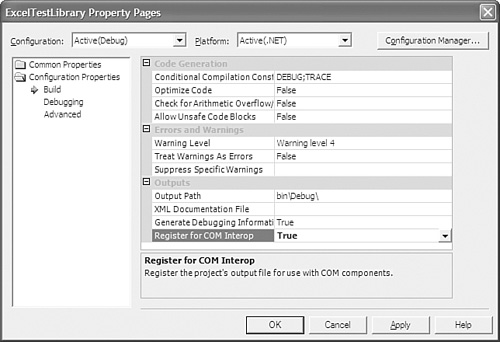One of the issues with NUnit is it is focused specifically on testing .NET solutions. In the real world, you might have Visual Basic, C++ solutions as well as .NET C# and VB.NET code. I like to have one place where I can run all the tests for the entire system. Using Excel is fairly generic, and most languages can expose a COM interface for Excel to work with. In the following exercise, we will build a simple framework with C# and VBA in Excel.
In this exercise, we build a test framework for a .NET class library using Excel as the main engine and tests that are exposed in the form of a COM interface. So let’s get into it:
Create a new C# class library called ExcelTestLibrary.
In the Class1.cs file, create a class that supports a COM interface so that we can call it from Excel. We can use the ClassInterface attribute, as shown:
using System; using System.Runtime.InteropServices; namespace ExcelTestLibrary { [ClassInterface(ClassInterfaceType.AutoDual)] public class Tests { public int TestCount { get { return 2; } } public string[] RunTests() { string[]results = new string[2]; results[0] = Test1(); results[1] = Test2(); return results; } private string Test1() { return "Success: Test1 Ran"; } private string Test2() { return "Failure: Test2 Ran"; } } }In Solution Explorer, right-click the project and select Properties to bring up the Property Pages dialog box. In the Configuration Properties / Build section, set the Register for COM Interop Output to True, as shown in Figure A-1. This will generate a type library and register it in the system Registry.
Build the library. Now we can fire up Excel and call the COM interface to run the tests.
Load Excel with a blank spreadsheet. Press Alt+F11 to fire up the Visual Basic Editor to enter a macro. Double-click ThisWorkbook in the project view in the upper-right corner. This brings up a blank Code Entry sheet. In this, we create a macro called RunTests, as shown:
Sub RunTests() Dim testLib As New ExcelTestLibrary.Tests Dim results() As String results = testLib.RunTests() Dim nTest As Integer Dim result As String Dim resultRow As Range For nTest = 0 To testLib.TestCount - 1 result = results(nTest) Set resultRow = Range(Sheet1.Cells(nTest + 1, 1), Sheet1.Cells(nTest + 1, 10)) If Left(result, 7) = "Success" Then resultRow.Interior.Color = RGB(0, 255, 0) Else resultRow.Interior.Color = RGB(255, 0, 0) End If Sheet1.Cells(nTest + 1, 1) = result Next End SubRun the macro and have a look at the spreadsheet. You should see the results highlighted in Figure A-2.
(Optional) Enhancing the solution. There are a number of things you can do to make this framework more useful.
Save the sheet after the tests have run into an archive so that you can track the progress of tests through the project life cycle.
Format the sheet with headings so that it is presentable to management as an output of the build and test process.
Create a mechanism to return the success or failure output as a Boolean separately from a results string.
Think of how you can incorporate this into your solution at work.


